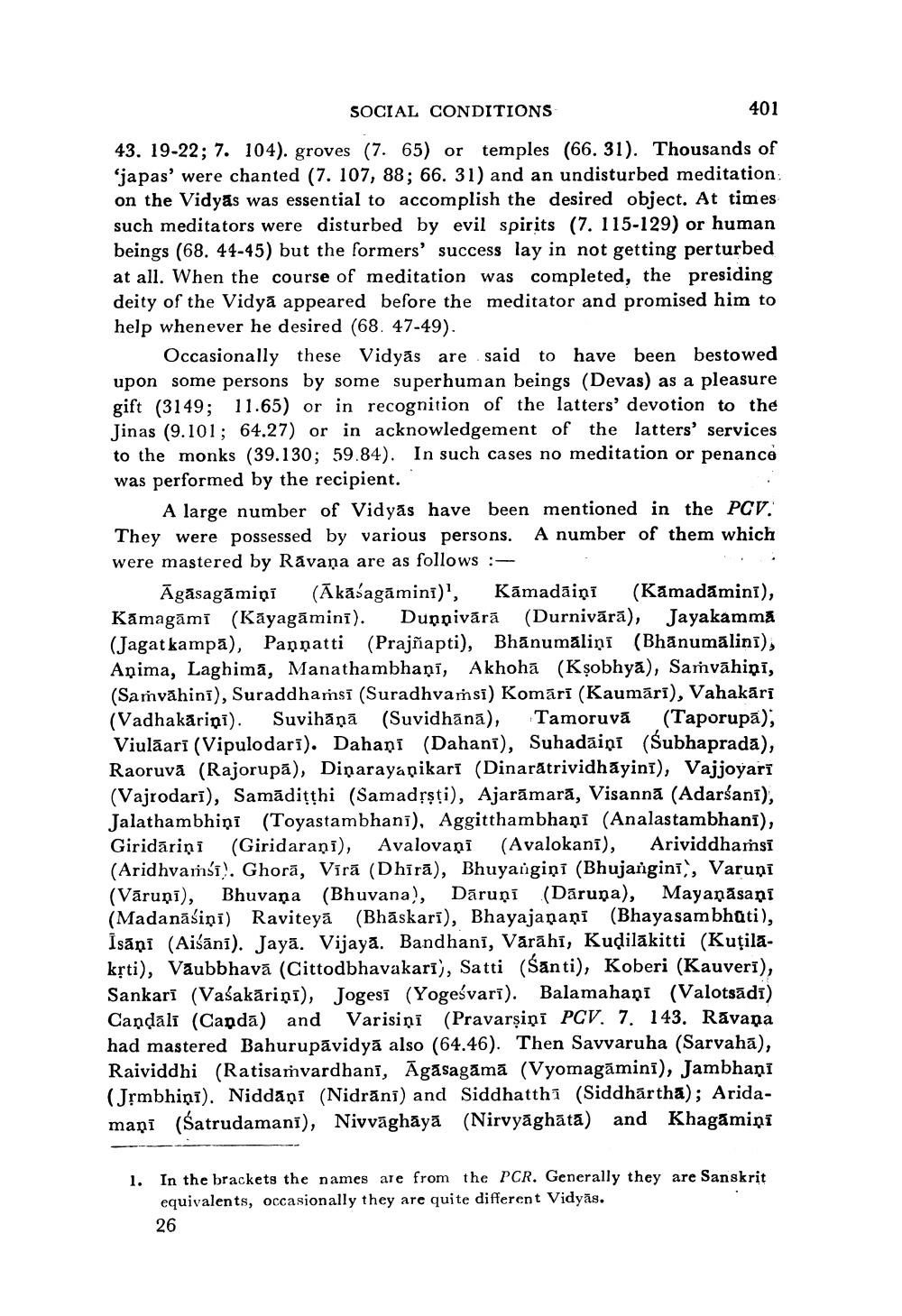________________
SOCIAL CONDITIONS
401
43. 19-22; 7. 104). groves (7. 65) or temples (66. 31). Thousands of 'japas' were chanted (7. 107, 88; 66. 31) and an undisturbed meditation on the Vidyas was essential to accomplish the desired object. At times such meditators were disturbed by evil spirits (7. 115-129) or human beings (68. 44-45) but the formers' success lay in not getting perturbed at all. When the course of meditation was completed, the presiding deity of the Vidya appeared before the meditator and promised him to help whenever he desired (68. 47-49).
Occasionally these Vidyas are said to have been bestowed upon some persons by some superhuman beings (Devas) as a pleasure gift (3149; 11.65) or in recognition of the latters' devotion to the Jinas (9.101; 64.27) or in acknowledgement of the latters' services to the monks (39.130; 59.84). In such cases no meditation or penance was performed by the recipient.
A large number of Vidyas have been mentioned in the PCV. They were possessed by various persons. A number of them which were mastered by Ravana are as follows :
Āgāsagāmiņī (Ākāśagāmini)1, Kāmadāiņī (Kāmadāminī), Kāmagāmī (Kāyagāminī). Duppivārā (Durnivārā), Jayakammā (Jagat kampa), Pannatti (Prajñapti), Bhānumāliņī (Bhānumālinī), Anima, Laghima, Manathambhaņi, Akhoha (Kṣobhya), Saṁvāhiņi, (Samvahini), Suraddhamsi (Suradhvaṁsi) Komārī (Kaumārī), Vahakārī (Vadhakariņi). Suvihāņā (Suvidhānā), Tamoruvā (Taporupā); Viulaari (Vipulodari). Dahaņi (Dahani), Suhadaiņi (Subhaprada), Raoruva (Rajorupā), Dinarayaņikarī (Dinarātrividhāyinī), Vajjoyarī (Vajrodari), Samadiṭṭhi (Samadṛṣṭi), Ajarāmarā, Visannā (Adarśani), Jalathambhiņi (Toyastambhani), Aggitthambhanī (Analastambhanī), Giridāriņi (Giridaraņi), Avalovaņī (Avalokanī), Arividdhaṁsī (Aridhvams). Ghora, Vīrā (Dhira), Bhuyangiņi (Bhujangini,, Varuņi (Vāruņi), Bhuvana (Bhuvana), Daruņi (Daruņa), Mayanāsaņī (Madanāsiņi) Raviteya (Bhaskari), Bhayajanani (Bhayasambhuti), Īsāņi (Aiśānī). Jaya. Vijaya. Bandhani, Vārāhī, Kudilākitti (Kuțilakṛti), Vaubbhava (Cittodbhavakarī), Satti (Śanti), Koberi (Kauveri), Sankari (Vaśakāriņī), Jogesī (Yogeśvari). Balamahani (Valotsādī) Candali (Canda) and Varisiņi (Pravarșini PCV. 7. 143. Ravana had mastered Bahurupāvidya also (64.46). Then Savvaruha (Sarvahā), Raividdhi (Ratisamvardhani, Agasagāmā (Vyomagāminī), Jambhani (Jṛmbhiņi). Niddāņi (Nidrānī) and Siddhattha (Siddharthā); Aridamaņi (Śatrudamani), Nivvāghāyā (Nirvyāghātā) and Khagāmiņī
1.
In the brackets the names are from the PCR. Generally they are Sanskrit equivalents, occasionally they are quite different Vidyas.
26




